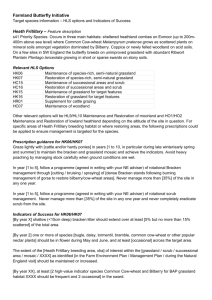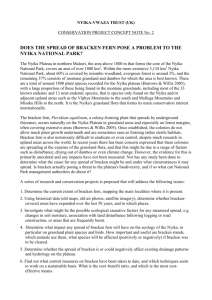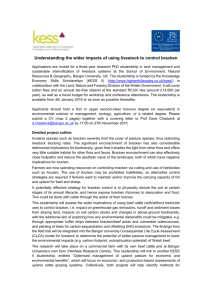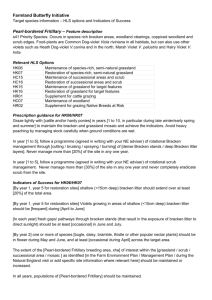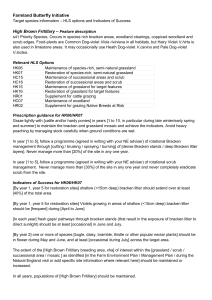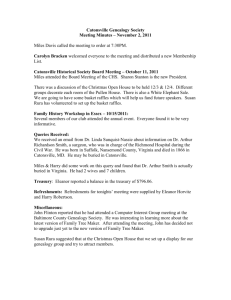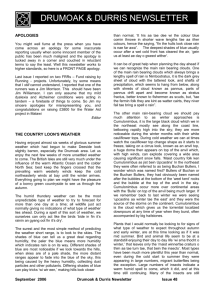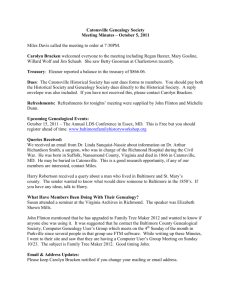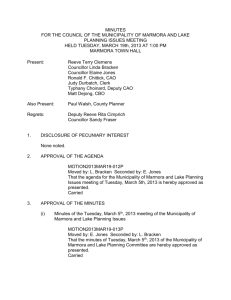Small Pearl-bordered Fritillary
advertisement
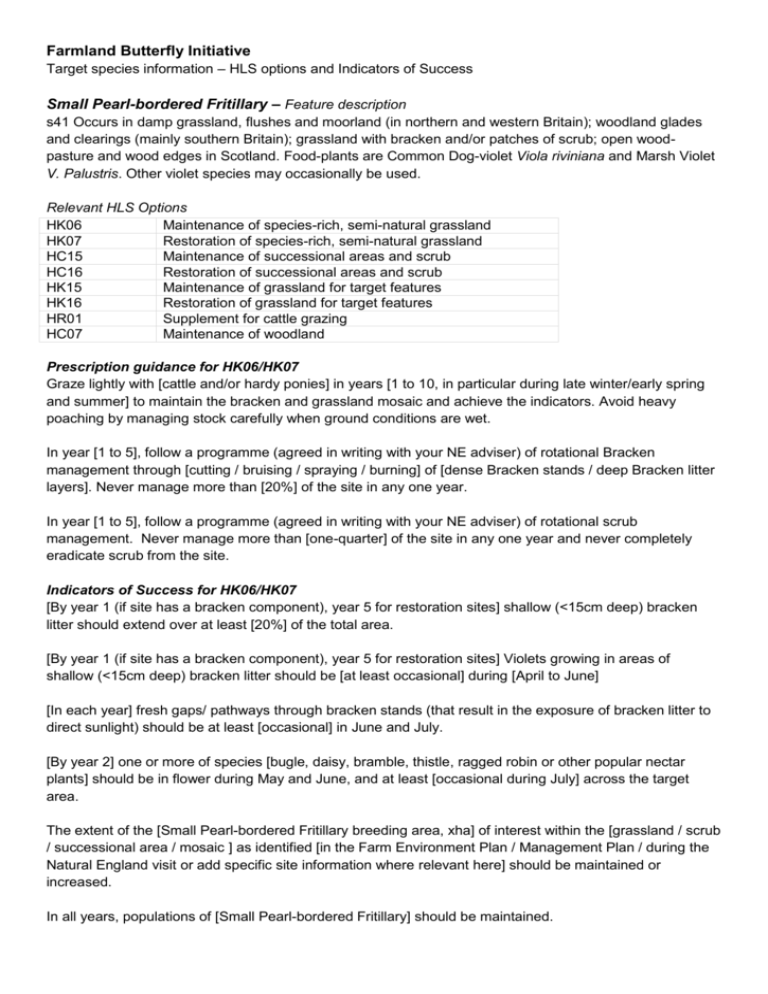
Farmland Butterfly Initiative Target species information – HLS options and Indicators of Success Small Pearl-bordered Fritillary – Feature description s41 Occurs in damp grassland, flushes and moorland (in northern and western Britain); woodland glades and clearings (mainly southern Britain); grassland with bracken and/or patches of scrub; open woodpasture and wood edges in Scotland. Food-plants are Common Dog-violet Viola riviniana and Marsh Violet V. Palustris. Other violet species may occasionally be used. Relevant HLS Options HK06 Maintenance of species-rich, semi-natural grassland HK07 Restoration of species-rich, semi-natural grassland HC15 Maintenance of successional areas and scrub HC16 Restoration of successional areas and scrub HK15 Maintenance of grassland for target features HK16 Restoration of grassland for target features HR01 Supplement for cattle grazing HC07 Maintenance of woodland Prescription guidance for HK06/HK07 Graze lightly with [cattle and/or hardy ponies] in years [1 to 10, in particular during late winter/early spring and summer] to maintain the bracken and grassland mosaic and achieve the indicators. Avoid heavy poaching by managing stock carefully when ground conditions are wet. In year [1 to 5], follow a programme (agreed in writing with your NE adviser) of rotational Bracken management through [cutting / bruising / spraying / burning] of [dense Bracken stands / deep Bracken litter layers]. Never manage more than [20%] of the site in any one year. In year [1 to 5], follow a programme (agreed in writing with your NE adviser) of rotational scrub management. Never manage more than [one-quarter] of the site in any one year and never completely eradicate scrub from the site. Indicators of Success for HK06/HK07 [By year 1 (if site has a bracken component), year 5 for restoration sites] shallow (<15cm deep) bracken litter should extend over at least [20%] of the total area. [By year 1 (if site has a bracken component), year 5 for restoration sites] Violets growing in areas of shallow (<15cm deep) bracken litter should be [at least occasional] during [April to June] [In each year] fresh gaps/ pathways through bracken stands (that result in the exposure of bracken litter to direct sunlight) should be at least [occasional] in June and July. [By year 2] one or more of species [bugle, daisy, bramble, thistle, ragged robin or other popular nectar plants] should be in flower during May and June, and at least [occasional during July] across the target area. The extent of the [Small Pearl-bordered Fritillary breeding area, xha] of interest within the [grassland / scrub / successional area / mosaic ] as identified [in the Farm Environment Plan / Management Plan / during the Natural England visit or add specific site information where relevant here] should be maintained or increased. In all years, populations of [Small Pearl-bordered Fritillary] should be maintained. Prescription guidance for HC15/HC16 Graze lightly with [cattle and/or hardy ponies] in years [1 to 10, in particular during late winter/early spring and summer] to maintain the bracken and grassland mosaic and achieve the indicators. Avoid heavy poaching by managing stock carefully when ground conditions are wet. In year [1 to 5], follow a programme (agreed in writing with your NE adviser) of rotational Bracken management through [cutting / bruising / spraying / burning] of [dense Bracken stands / deep Bracken litter layers]. Never manage more than [20%] of the site in any one year. In year [1 to 5], follow a programme (agreed in writing with your NE adviser) of rotational scrub management. Never manage more than [30%] of the site in any one year and never completely eradicate scrub from the site. Indicators of Success for HC15/HC16 [By year 1 (if site has a bracken component), year 5 for restoration sites] shallow (<15cm deep) bracken litter should extend over at least [20%] of the total area. [By year 1, year 5 for restoration sites] Violets growing in areas of shallow (<15cm deep) bracken litter should be [frequent] during [April to June] [In each year] fresh gaps/ pathways through bracken stands (that result in the exposure of bracken litter to direct sunlight) should be at least [occasional] in June and July. [By year 2] one or more of species [bugle, daisy, bramble, thistle, ragged robin or other popular nectar plants] should be in flower during May and June, and at least [occasional during July] across the target area. Prescription guidance for HK15/HK16 Graze lightly with [cattle and/or hardy ponies] in years [1 to 10, in particular early spring and summer, at least 6 weeks grazing between May and September] to maintain the bracken and grassland mosaic and achieve the indicators. Avoid heavy poaching by managing stock carefully when ground conditions are wet. In year [1 to 5], follow a programme (agreed in writing with your NE adviser) of rotational Bracken management through [cutting / bruising / spraying / burning] of [dense Bracken stands / deep Bracken litter layers]. Never manage more than [20%] of the site in any one year. In year [1 to 5], follow a programme (agreed in writing with your NE adviser) of rotational scrub management. Never manage more than [30%] of the site in any one year and never completely eradicate scrub from the site. Indicators of Success for HK15/HK16 In all years, populations of [Small Pearl-bordered Fritillary] should be maintained. [By year X] shallow (<15cm deep) bracken litter should extend over at least [20%] of the total area. [By year X] Violets growing in areas of shallow (<15cm deep) bracken litter should be [at least frequent] during [April to June] [In each year] fresh gaps/ pathways through bracken stands (that result in the exposure of bracken litter to direct sunlight) should be at least [occasional] in June and July. [By year 2] one or more of species [bugle, daisy, bramble, thistle, ragged robin or other popular nectar plants] should be in flower during May and June, and at least [occasional during July] across the target area. Prescription guidance for HR01 Cattle will be the [main] grazing species [during the year, timing not specific but needs some winter grazing to trample bracken]. They will comprise [at least 70% along with ponies and sheep] of the livestock unit grazing days on the parcel. Prescription guidance for HC07 Maintain open features, including rides and glades. Indicators of Success for HC07 A network of rides and open ground should cover between [10% and 30%] of the area. Further Information Occurs in damp, grassy habitats as well as woodland clearings and moorland. The adults fly from late May until the end of June. The butterfly remains widespread in Scotland and Wales, but has undergone a severe decline in England. It breeds in three main habitats in England: woodland glades and clearings (mainly in south); damp grassland and moorland (in west and north); grassland with bracken and/or patches of scrub. Other habitats used include dune slacks and coastal cliffs. In all habitats it breeds in damp, grassy vegetation where there is abundant foodplant (violets) growing in a fairly lush sward. The most widely used foodplants are Common Dog-violet and Marsh Violet. It may occasionally feed on other violet species. The eggs are laid singly, either on plants or dead vegetation near to violets and sometimes on the foodplant itself, or by dropping them while crawling amongst low vegetation. The larvae feed until their fourth instar when they hibernate, probably amongst the leaf litter. They emerge to feed again during spring but, unlike Pearl-bordered Fritillary larvae, they rarely bask and spend most of their time concealed amongst the vegetation, only coming out for short bouts of feeding. They pupate close to the ground, hidden deep within vegetation. Damp grassland, flushes and moorland habitats Aim to maintain damp or heathy vegetation where violets (often Marsh Violets) are abundant in medium height swards and suitable nectar sources are available. Waterlogged sites can be unsuitable especially under very acidic conditions. Grazing Extensive light cattle grazing is ideal, as some poaching encourages violet regeneration. Heavy grazing, especially by sheep, is detrimental. Where grazing is impractical autumn mowing and raking can be effective in maintaining suitable habitat. Scrub Clearance Scrub clearance can be undertaken as required, especially when acting as a barrier to colonisation. On open, exposed sites some planting of perimeter shelterbelts will increase habitat suitability. On afforested stream edges clearance of conifers and brash 5-10m back can create ideal habitat. Grassland with Bracken and/or scrub Aim to maintain abundant violets in medium height swards, in association with Bracken or scrub edges. Grazing Bracken/grassland mosaics encourage an abundant supply of violets by suppressing grass growth. Aim to maintain a light Bracken cover. Extensive cattle or pony grazing is ideal, especially in winter and early spring, as the trampling helps break up the dense standing trash which suppresses violet and grass growth. Some sites may be maintained by sheep grazing, though they are not as effective at trampling Bracken. Bracken cutting and bruising In areas where dense Bracken is established it may be necessary to control through cutting or buising. Small-scale autumn and winter raking and disturbance of dense Bracken litter can also be beneficial. Periodic (3-10 year rotation) Bracken cutting by swipe in late May or early June can be used on ungrazed or too lightly grazed sites. Bruising by machine or by hand in June may also reduce Bracken densities. Scrub clearance (or burning) on a 5-10 year rotation can be undertaken, but scrub should not be eliminated as it often provides shelter. Woodland glades and clearings Aim to ensure a supply of flower-rich, sunny, open clearings and rides, especially where soils are damp and the vegetation lush. Traditional coppice management, where adjacent woodland plots are cut in succession, produces ideal conditions for the butterfly. Glade creation and ride widening can help to sustain populations. A Factsheet (with ideal habitat management photographs) is available from Butterfly Conservation’s website which can be given to landowners.
